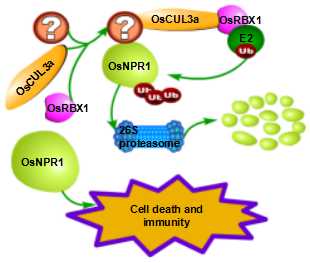分享到
OsCUL3a Negatively Regulates Cell Death and Immunity by Degrading OsNPR1 in Rice
The ubiquitin/proteasome pathway is a major system for the selective degradation of proteins in eukaryotes. Previous studies in plants have demonstrated that the ubiquitin/proteasome pathway is an essential component of the regulatory networks controlling many important cellular processes, including growth and development, as well as defense responses. Among the three major enzymes in this pathway, the E3 ubiquitin ligases are responsible for controlling the specificity of target protein recognition and degradation via the 26S proteasome. A prominent subset of the E3 ligases are the Cullin-RING E3 ligases (CRLs), in which the Cullin3 (CUL3)protein is known to function in the regulation of PCD in animals. In plants, the transcription coactivator NPR1 (NONEXPRESSOR OF PATHOGENESIS-RELATED GENES 1) is a master regulator of both basal and systemic acquired resistance (SAR). OsNPR1 over-expression rice plants have enhanced resistance to the bacterial pathogen Xanthomonas oryzae pv. Oryzae (Xoo), elevated expression levels of pathogenesis-related (PR) genes, and a benzothiadiazole-mediated cell death phenotype. Although OsNPR1 has been identified as a positive regulator of resistance against bacterial pathogens, its protein turnover and molecular mechanism remain largely unknown.
Recently, researchers from China National Rice Research Institute (CNRRI), Institute of Plant Protection, Chinese Academy of Agricultural Sciences, The Ohio State University, Zhejiang Key Laboratory of Super Rice Research and Henan Agricultural University identified a rice lesion mimic mutant, oscul3a, in a mutant collection. Their research findings show mutant oscul3a displays a significant increase in the accumulation of flg22- and chitin-induced reactive oxygen species, and in pathogenesis-related gene expression as well as resistance to Magnaporthe oryzae and Xanthomonas oryzae pv. oryzae. They cloned the OsCUL3a gene via a map-based strategy and found that the lesion mimic phenotype of oscul3a is associated with the early termination of OsCUL3a protein. Interaction assays showed that OsCUL3a interacts with both OsRBX1a and OsRBX1b to form a multi-subunit CRL in rice. Strikingly, OsCUL3a interacts with and degrades OsNPR1, which acts as a positive regulator of cell death in rice. Accumulation of OsNPR1 protein is greater in the oscul3a mutant than in the wild type. Furthermore, the oscul3a osnpr1 double mutant does not exhibit the lesion mimic phenotype of the oscul3a mutant. The result demonstrates that OsCUL3a negatively regulates cell death and immunity by degrading OsNPR1 in rice.
This researchwas supported by the National Key Transgenic Program (2016ZX08001002), the Agricultural Science and Technology Innovation Program of Chinese Academy of Agricultural Sciences (CAAS-ASTIP-2013-CNRRI), the National Natural Science Foundation of China (#31571944), and the China Association for Science and Technology. The research finding has been published in Plant Cell online on January 18, 2016 (DOI: 10.1105/tpc.16.00650). More details are available on the links bellow: http://m.plantcell.org/content/early/2017/01/18/tpc.16.00650


Recently, researchers from China National Rice Research Institute (CNRRI), Institute of Plant Protection, Chinese Academy of Agricultural Sciences, The Ohio State University, Zhejiang Key Laboratory of Super Rice Research and Henan Agricultural University identified a rice lesion mimic mutant, oscul3a, in a mutant collection. Their research findings show mutant oscul3a displays a significant increase in the accumulation of flg22- and chitin-induced reactive oxygen species, and in pathogenesis-related gene expression as well as resistance to Magnaporthe oryzae and Xanthomonas oryzae pv. oryzae. They cloned the OsCUL3a gene via a map-based strategy and found that the lesion mimic phenotype of oscul3a is associated with the early termination of OsCUL3a protein. Interaction assays showed that OsCUL3a interacts with both OsRBX1a and OsRBX1b to form a multi-subunit CRL in rice. Strikingly, OsCUL3a interacts with and degrades OsNPR1, which acts as a positive regulator of cell death in rice. Accumulation of OsNPR1 protein is greater in the oscul3a mutant than in the wild type. Furthermore, the oscul3a osnpr1 double mutant does not exhibit the lesion mimic phenotype of the oscul3a mutant. The result demonstrates that OsCUL3a negatively regulates cell death and immunity by degrading OsNPR1 in rice.
This researchwas supported by the National Key Transgenic Program (2016ZX08001002), the Agricultural Science and Technology Innovation Program of Chinese Academy of Agricultural Sciences (CAAS-ASTIP-2013-CNRRI), the National Natural Science Foundation of China (#31571944), and the China Association for Science and Technology. The research finding has been published in Plant Cell online on January 18, 2016 (DOI: 10.1105/tpc.16.00650). More details are available on the links bellow: http://m.plantcell.org/content/early/2017/01/18/tpc.16.00650


By Luo Ju
luojurice@126.com
luojurice@126.com
Latest News
-
 Apr 18, 2024Opening Ceremony of the Training Workshop on Wheat Head Scab Resistance Breeding and Pest Control in Africa Held in CAAS
Apr 18, 2024Opening Ceremony of the Training Workshop on Wheat Head Scab Resistance Breeding and Pest Control in Africa Held in CAAS -
 Apr 03, 2024IPPCAAS Co-organized the Training Workshop on Management and Application of Biopesticides in Nepal
Apr 03, 2024IPPCAAS Co-organized the Training Workshop on Management and Application of Biopesticides in Nepal -
 Mar 28, 2024Delegation from the School of Agriculture and Food Science of University College Dublin, Ireland Visit to IAS, CAAS
Mar 28, 2024Delegation from the School of Agriculture and Food Science of University College Dublin, Ireland Visit to IAS, CAAS -
 Mar 25, 2024Director of World Food Prize Foundation visited GSCAAS
Mar 25, 2024Director of World Food Prize Foundation visited GSCAAS -
 Mar 20, 2024Institute of Crop Sciences (ICS) and Syngenta Group Global Seeds Advance Collaborative Research in the Seed Industry
Mar 20, 2024Institute of Crop Sciences (ICS) and Syngenta Group Global Seeds Advance Collaborative Research in the Seed Industry
